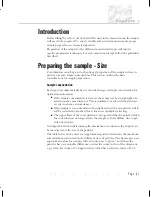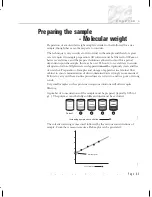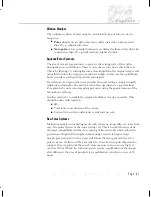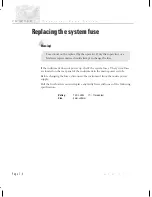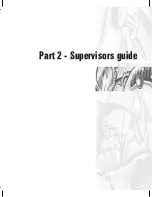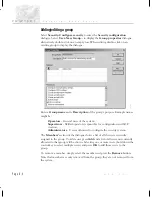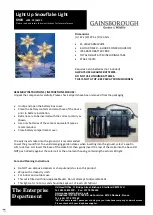
Dilution Medium
The continuous phase of most samples can arbitrarily be put into one of two
categories:
.
Polar
dispersants are defined as those with a dielectric constant greater
than 20 e.g. ethanol and water.
.
Non-polar
or low polarity dispersants are defined as those with a dielectric
constant less than 20, e.g. hydrocarbons, higher alcohols.
Aqueous/Polar Systems
The aim of sample preparation is to preserve the existing state of the surface
during the process of dilution. There is only one way to ensure this is the case.
This is by filtering or centrifuging some clear liquid form the original sample and
using this to dilute the original concentrated sample. In this way the equilibrium
between surface and liquid is perfectly maintained.
If extraction of a supernatant is not possible, then just letting a sample naturally
sediment and using the fine particles left in the supernatant is a good method.
Zeta potential is not a size-dependent parameter using the approximation of the
Smoluchowski theory.
Another method is to imitate the original medium as closely as possible. This
should be done with regard to:
.
pH.
.
Total ionic concentration of the system.
.
Concentration of any surfactants or polymers present.
Non-Polar Systems
Measuring samples in insulating media such as hexane, isoparaffin, etc. is far from
easy. It requires the use of the universal dip cell. This is required because of its
chemical compatibility and the close spacing of the electrodes which allows the
generation of high field strengths without using excessively high voltages.
Sample preparation for such systems will follow the same general rules as for
polar systems. As there will be generally fewer ions in a non polar dispersant to
suppress the zeta potential, the actual values measured can seem very high, as
much as 200 or 250mV. In such non-polar systems, equilibration of the sample
after dilution is the time dependent step, equilibration can take in excess of 24
hours.
C H A P T E R 6
Z
e
t
a
s
i
z
e
r
N
a
n
o
S
e
r
i
e
s
P a g e 6 . 7
Summary of Contents for Zetasizer Nano Series
Page 7: ...Part 1 Operators guide Part 1 Operators guide...
Page 8: ......
Page 9: ...Introduction to this manual Introduction to this manual C H A P T E R 1...
Page 10: ......
Page 16: ...C H A P T E R 1 Z e t a s i z e r N a n o S e r i e s Page 1 6 M A N 0 3 1 7...
Page 17: ...What is the Zetasizer Nano What is the Zetasizer Nano C H A P T E R 2...
Page 18: ......
Page 26: ...C H A P T E R 2 Z e t a s i z e r N a n o S e r i e s Page 2 8 M A N 0 3 1 7...
Page 27: ...How does the Zetasizer Nano work How does the Zetasizer Nano work C H A P T E R 3...
Page 28: ......
Page 51: ...Making measurements A tutorial Making measurements A tutorial C H A P T E R 4...
Page 52: ......
Page 78: ......
Page 90: ...C H A P T E R 5 Z e t a s i z e r N a n o S e r i e s Page 5 12 M A N 0 3 1 7...
Page 91: ...Sample Preparation Sample Preparation C H A P T E R 6...
Page 92: ......
Page 100: ...C H A P T E R 6 Z e t a s i z e r N a n o S e r i e s Page 6 8 M A N 0 3 1 7...
Page 101: ...Maintenance Maintenance C H A P T E R 7...
Page 102: ......
Page 107: ...Part 2 Supervisors guide Part 2 Supervisors guide...
Page 108: ......
Page 109: ...Security Security C H A P T E R 8...
Page 110: ......
Page 118: ...C H A P T E R 8 Z e t a s i z e r N a n o S e r i e s Page 8 8 M A N 0 3 1 7...
Page 119: ...Using SOPs Using SOPs C H A P T E R 9...
Page 120: ......
Page 152: ......
Page 161: ...Exporting results Exporting results C H A P T E R 1 1...
Page 162: ......
Page 168: ...C H A P T E R 1 1 Z e t a s i z e r N a n o S e r i e s Page 11 6 M A N 0 3 1 7...
Page 169: ...Creating custom reports Creating custom reports C H A P T E R 1 2...
Page 170: ......
Page 183: ...Size theory Size theory C H A P T E R 1 3...
Page 184: ......
Page 193: ...Molecular Weight theory Molecular Weight theory C H A P T E R 1 4...
Page 194: ......
Page 200: ...C H A P T E R 1 4 Z e t a s i z e r N a n o S e r i e s Page 14 6 M A N 0 3 1 7...
Page 201: ...Zeta Potential theory Zeta Potential theory C H A P T E R 1 5...
Page 202: ......
Page 215: ...Part 3 Appendices Part 3 Appendices...
Page 216: ......
Page 217: ...Health and Safety Health and Safety A P P E N D I X A...
Page 218: ......
Page 223: ...Specification Specification A P P E N D I X B...
Page 224: ......
Page 227: ...Site requirements f r o m M A N 0 3 1 7 I s s u e 1 0 Site requirements A P P E N D I X C...
Page 237: ...Installation Installation A P P E N D I X E...
Page 238: ......
Page 241: ...Regulatory Statements Regulatory Statements A P P E N D I X F...
Page 242: ......
Page 246: ...A P P E N D I X F Z e t a s i z e r N a n o S e r i e s Page F 4 M A N 0 3 1 7...
Page 247: ...Index Index...
Page 248: ......









